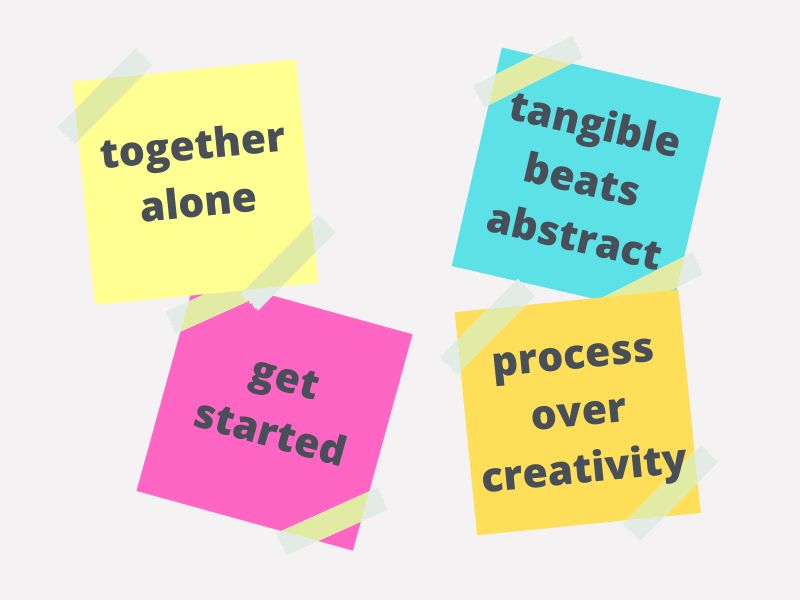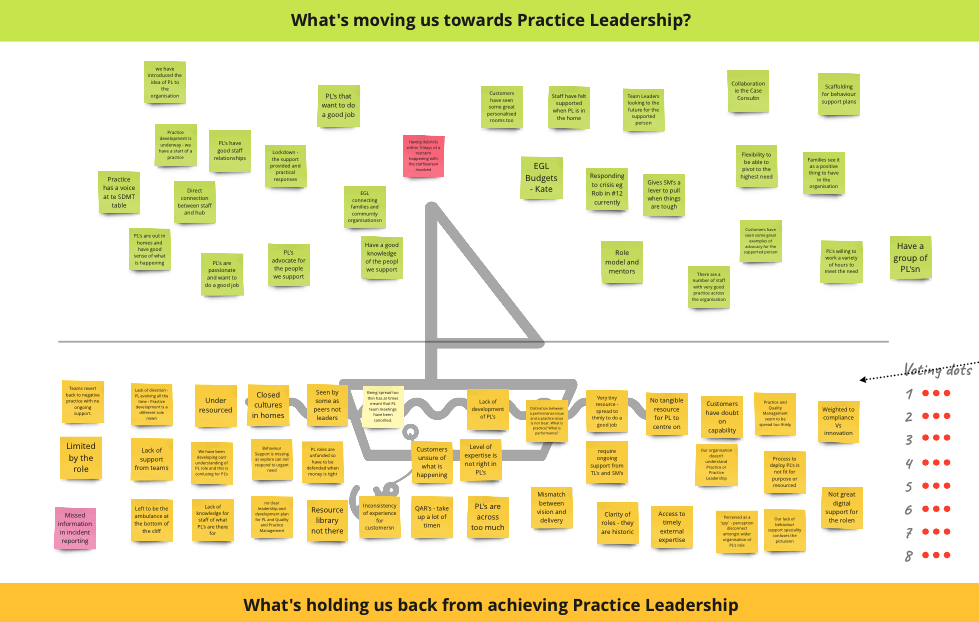Do you get frustrated with meetings?
I know I do.
No matter what organisation or job role, wherever people work together as a team (innovation projects), there are some common challenges that I’ve noticed:
- Meetings leave you more confused without clear outcomes.
- Changing priorities and goals.
- A loss of focus leading to frustration and a lack of progress.
- Compromises rather than clear decision-making.
This situation is all caused by a lack of structure.
The solution is to replace the loose format with a structured workshop which enables creativity, aligned decisions and enhanced results.
It’s called the decision sprint.
Structured workshops result in clarity and momentum. Unstructured meetings result in confusion and procrastination.
Read time: 5 minutes (or less) 👇
Today, I’ll cover:
- 4 decision-making principles.
- Decision sprint overview.
- The LEAP framework.
- The decision sprint step by step guide.
Let’s get going!
Decision Sprint Principles

The 4 decision-making principles come from the design sprint.
1) Together, alone. Together, alone means that on some of the exercises, individuals will be working on ideas themselves and then sharing their ideas back to the team.
This principle helps to give airtime to introverts and manages the more dominant characters so everyone can get their thoughts and ideas out.
2) Tangible beats abstract. Rather than circular discussions, creating things visually communicates so much more and provides clarity of concepts.
3) Getting started over being right. One for the procrastinators (myself included). It’s not about the perfect solution, it is about moving forward and evolving things as you go.
4) Process over creativity. The good news is that you don’t need to be the ‘creative type’ or in the mood for creativity. The process helps produce solutions that can be creative.
Decision Sprint Overview
The overview covers the when, who, how and what of the decision sprint.
When to use a decision sprint?
Use the decision sprint anytime your team needs to make a decision and progress on a problem or challenge, like:
- Your marketing strategy.
- Organising a client event.
- Streamlining your recruitment process.
- How to make more sales.
Who should be involved?
That depends.
Like most situations, more people, leads to things taking longer and becoming less focused.
You’ll need to make a judgement call, but I find around 7 people is a good size. So, depending on the problem it could be one member from each department or members from the same department.
Who leads the meeting?
Ideally, the facilitator will be someone that has the authority to make any final decision.
The person could be a manager or a team member that has been appointed to run the session.
The important aspect is that all members support the facilitator to make any final decisions and they can be steered back on track if the meeting starts to loose focus.
How much time is needed for a decision sprint?
Again that depends on the problem.
A rule of thumb is that broader, more in-depth problems may require up to 2 hours. Narrower, more superficial problems may only require about 30 minutes.
What is needed for a decision sprint?
If you’re running an in-person decision sprint, I would recommend these materials:
- A room to allow the sprint without interruption and space for interaction.
- Larger rectangular post-it notes.
- Standard square post-it notes – yellow plus two other colours.
- Sharpies or similar felt pens.
- Small red sticky dots for team members to vote.
- Large green sticky dots for the decision-maker to vote.
- A timer that can be seen by all the team.
- A large whiteboard or surface area.
If you are running a remote decision sprint, then I would recommend using Miro or Mural, the real-time collaborative virtual whiteboards.
The LEAP Framework
The LEAP framework is based off the design thinking process and condensed for a decision sprint.

Learn stands for the information gathering phase. Things like challenges, ideas, research or anything else that surfaces.
E is the extract phase is when choices are made as to what to focus on and what not to. This is important for alignment and direction.
A stands for make. This phase is about creating several potential solutions even if some don’t progress.
P is the prioritise phase. Solutions will be prioritised and next steps decided.
The Decision Sprint Step by Step Guide
The decision sprint uses the LEAP framework to tackle decision-making, fast.
There are several techniques to use within the phases. Here are my go-to approaches:
The learn phase.

The learn phase is about gathering all the perspectives and being able to visualise them into themes.
The sailboat exercise is a good way to start a decision sprint and have everyone in a positive mindset.
1) Draw a sailboat on the whiteboard. Above the waterline are things that will take us forward. Below the waterline will be placed things that are holding us back.
2) Allocate 3 minutes for team members to write what is moving the team forward. Each item is written on an individual post-it note.
3) Each team member steps up to the white board and reads aloud each item to the group as they place them above the waterline.
4) Each member writes what is ‘holding us back’. Give more time to do this because it may take deeper thought.
5) This time though everyone places the notes on the board at the same time without reading aloud.
6) Organise the challenges under themes or categories like in an affinity map.
The extract phase.
The extract phase helps to select what to focus on and then turning them into opportunities.
1) Give each member 8 red dots and 8 minutes to vote on any of the challenges that they think are the most critical. This is a together, alone activity.
2) Order the challenges in a sequence of those that have the most votes at the top to those that have the least.
3) Eliminate anything that doesn’t have a dot or only 1 dot. These are not worth continuing with.
4) Rewrite the top challenges into opportunities using the “how might we…” framework. And, choose one.
For example, if a challenge was ‘social media is confusing’, change that into something like ‘how might we make it easier to learn social media?’
This process also creates a backlog of the next priorities once the chosen challenge has been completed.
The make phase.
The make phase is all about generating creative ideas to solve the selected challenge.
1) Ask each team member to write as many ideas to solve the selected ‘how might we …?’ challenge. Each idea is written onto a separate post-it note.
Remind them, we are after quantity of ideas, so just write.
2) After 10 minutes, ask each member to choose their favourite 5-10 ideas.
3) Stick them up on the wall. Everyone does this at the same time without arranging them.
4) Give several (7-10) red dots to each member and ask them to vote on the ideas that they think are most promising. Go with instinct and without deliberating.
5) Order the challenges in a sequence of those that have the most votes at the top to those that have the least.
6) Eliminate anything that doesn’t have a dot or only 1 dot. These are not worth considering.
The prioritise phase.

This phase is arguably the most important, because businesses often have good ideas but may struggle with to follow-through.
The effort / impact map is a good tool to use here.
1) Draw the map on a white board.
2)Take the top voted idea and holding it above the vertical impact axis ask your team to help determine the level of impact.
3) Then, using the same challenge, determine the effort using the horizontal axis and stick the post-it to the board.
4) Repeat for all the remaining ideas.
5) Take the ‘high impact, low effort’ quadrant items and turn them into a simple action plan. Make sure there is success criteria assigned.
6) Record all the actions and assign to team members.
That’s it. Impactful decisions made and prioritised into an action list in under 2 hours.
The short of it
- Often, typical meetings are frustring, a waste of time and ineffective.
- Use the decision sprint to run more aligned and effective decision-making meetings.
- Workshops are more fun.
If you enjoyed this newsletter, please share it with 1 other person.
That’s all.
Let’s achieve together.
🥇 Twitter Tip of the Week 🥇
The #1 way to improve customer experience is to build a connection.
— Vaughan Broderick (@theVBroderick) November 22, 2022
Now, you might be thinking 'I don't have time'.
Here's the impact a handwritten note can have: pic.twitter.com/ZRTajXQ525
🔥Meetings Quote🔥
“We’ll continue having lots of meetings until we find out why no work is getting done.” – unknown


